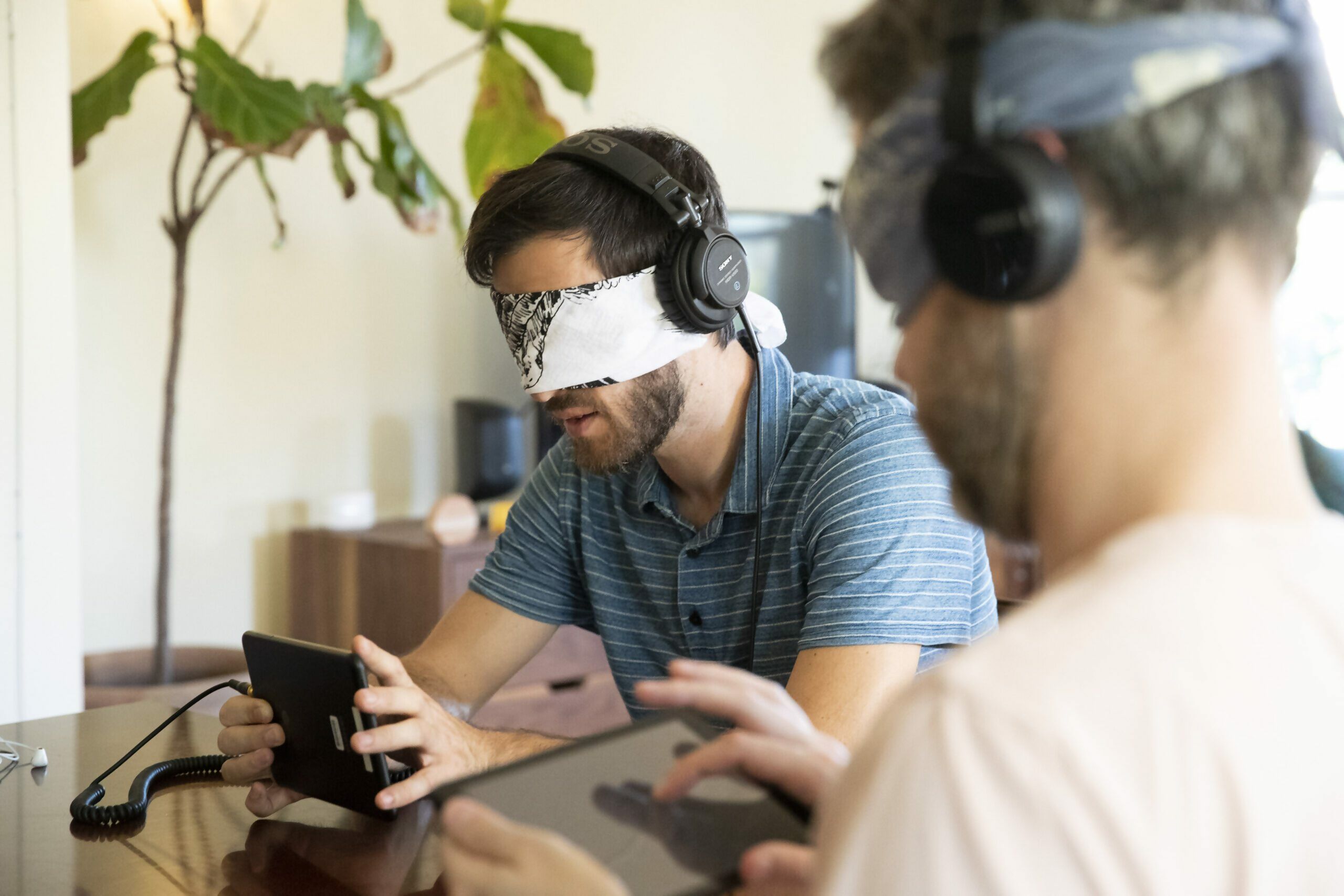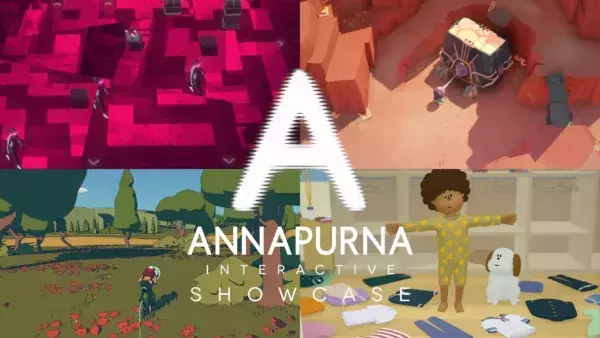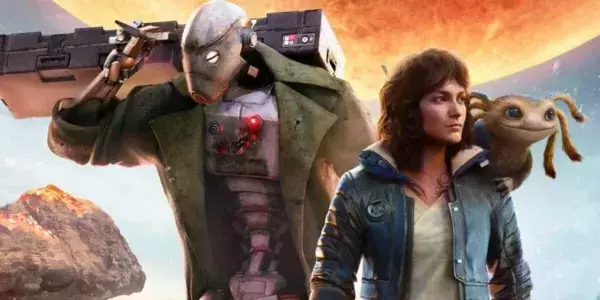
We usually think of video games as a visual medium – they’re called ‘video’ games for a reason, after all. But while this focus on visuals dominates discussion in the mainstream, a number of developers are working on projects that focus on non-visual feedback. This is something particularly important for blind and visually impaired players, as it’s often the only way they can play, and enjoy, a game like anyone else would.
Getting accurate figures for the number of blind and visually impaired players worldwide is tricky. Arianna Ortelli, from Italian startup NOVIS, says there are 253 million blind and visually impaired people in the world; about 170 million live in so-called ‘developed and developing countries’, and about 50–60 million of this sub-group are under 55 years old. Since about 40% of the population plays video games – by Ortelli’s own measure – NOVIS estimates around 23 million video games players in the world are blind and/or visually impaired.
What we know with more certainty is that blind people do play video games, and they play mainstream titles that aren’t even designed specifically with their needs in mind. TJ The Blind Gamer went blind at the age of 15 before deciding to set up both YouTube and Twitch channels, on which can be found mainstream games like Diablo III and Call of Duty.
TJ plays games by following sound effects and, sometimes, with a little help from his viewers and their comments (written as text and converted to audio). But these games aren’t, in the most part, designed around the needs of players with visual impairments, and if they are somehow accessible, it’s more an accidental effect of sound design and a haptic feedback system than anything else.

TJ The Blind Gamer created his YouTube and Twitch channels to educate about accessibility, and to encourage disabled gamers to learn games like Mortal Kombat.
In fact, during her Triple-A Gaming While Blind talk at 2018 GDC, EA Sports accessibility lead Karen Stevens explained how Electronic Arts improved the accessibility features of EA Sports games and created its accessibility portal after discovering there was already an existing (and significant) user base of visually impaired players.
“We already had an audience, but they were struggling,” she told those gathered. So what do mainstream games need to do in order to become genuinely accessible to blind and visually impaired users?

Blind players play EA’s Madden NFL following the commentary, “kind of like listening to a game on the radio,” says Karen Stevens.
Making games accessible
“The most important [accessibility feature] is voiced menus, typically through text-to-speech software,” says accessibility consultant Ian Hamilton. Text-to-speech software (screen readers) turn text and elements of user interfaces into voice, and is increasingly implemented as a basic feature of operating systems, as well as software like NVDA or JAWS. As Hamilton explains, both Unity and Unreal Engine are working on native cross-platform support for text-to-speech functionality. “It needs to happen quickly,” he says. “Any game available to players in the USA that includes text or voice chat functionality is required by law to ensure that the chat itself and any UI or info needed to navigate to it, and operate it, is fully accessible to blind gamers.”
Text-to-speech can make interface-based games fully accessible to visually impaired players, but titles involving exploration of environments need ways to make the digital space understandable through 3D sound design, audio equivalents for visual cues, assisted traversal, and other techniques. “Mainstream games already contain some of these things,” Hamilton says. “Games like Grand Theft Auto V and Forza 7 are already played by many blind gamers. So the question is how to build on that, to allow a more equal and more complete experience.”

Pixelnicks’ 2D action platformer Eagle Island implements many accessibility features, like text-to-speech and options for outlining characters and platforms.
In 2003, Matthew Atkinson and Sabahattin ‘Sebby’ Gucukoglu started adding features to Quake, with the intention of making it completely playable – even in multiplayer – by people with visual impairments. AccessibleQuake was the result, later renamed AudioQuake, with the game modified to be based on ‘earcons’ – sounds signalling either important gameplay and environmental elements or the lack thereof (like open spaces) – and proving it was possible for mainstream games to be converted to be accessible for people with visual impairments. Projects pop up periodically, like Brian A. Smith of Columbia University and his RAD (racing auditory display) audio-based interface that can be integrated into existing racing games, allowing blind players to get involved.
Fortunately, it’s not all the work of the hobbyists and modders – major publishers are stepping up. Ubisoft stands out for the accessibility features of its recent releases such as Far Cry New Dawn, The Division 2, and Ghost Recon Breakpoint. But a lot of video games still fail in this field, even as far as basic elements are concerned. For example, they use small fonts and don’t let players resize them – this can be a problem both for deaf and hard of hearing players (when subtitles can’t be resized), and for visually impaired players, many of whom rely on scalable UIs and on-screen elements that are easy to distinguish.
Then there are the platforms themselves – Nintendo has been inconsistent in its inclusion of accessibility options with its games, but the Switch features no accessibility options at all. The PS4 has limited text-to-speech functionality, while Steam doesn’t even work properly with existing screen readers. Microsoft, as those paying attention to the company might have guessed, has incorporated many accessibility functions in the Xbox One – a text-to-speech function called Narrator, a magnifier, a high-contrast mode, and the ‘co-pilot’ feature – allowing two controllers to be treated as one.

Sam Friedman hopes that “companies that develop phones will recognise vibration as a meaningful tool to employ” and improve their “versatility and complexity.”
Audio games
Oddly, in the past it was easier for visually impaired players to play some games – at least when it came to specific genres like text adventures and MUDs – with text-to-speech functions able to deal with games in their entirety, thanks to their 100% text-based nature. But the graphical arms race pulled things away from the text-only realms and into a world of far less accessible games. So it was of little surprise to see some developers step up to make games with no visuals, targeted explicitly at visually impaired players: audio games.
Developers of these titles were often blind themselves. “After losing my sight I searched for accessible games that were both interesting and challenging, but I found nothing that fitted my criteria,” explains audio games developer David Greenwood, of GMA Games. “The games I did find made little or no use of sounds as a means of providing information to the gamer.”
Audio games strongly rely on voiced narration, volume as a cue for distance perception, and stereo panning, with sounds heard in the left, centre, or right channel to guide spatial navigation. For example, a particular looping sound (an earcon) would play in the left channel if a particular object, or hazard, were to the left of the player’s avatar, with the sound becoming louder as players got closer to its source.
Audio games cover every mainstream genre: first-person shooters like Shades of Doom by GMA Games, Pokémon-esque RPGs like Manamon and Manamon 2: The Eternal Requiem by VGStorm, and adventure games like the Inquisitor series by Ivan Venturi (IV) Productions. Venturi, based in Italy, says the most popular audio games in his catalogue are racing titles like Audio Moto Championship, Audio Rally Racing, and AudioSpeed.

Ivan Venturi Productions is now working on Haunted Space, designed to be completely accessible to blind players and users with motor and cognitive disabilities.
Venturi – and the other developers we spoke to – acknowledge that audio games are only a niche market and highlight the limits of this kind of experience. Blind accessibility consultant SightlessKombat says: “The genre reached its peak and point of stagnation about 14 or 15 years ago and – other than a few notable innovations, exceptions, and concepts – hasn’t really progressed since.” Even a blind audio game developer like Greenwood agrees, and feels that audio games belong to the past: “I strongly believe that accessibility should be built-in during the development of new mainstream games from this point onwards.”
Moreover, audio games are usually completely inaccessible to deaf and hard-of-hearing players, and they miss the social aspects of traditional video games. “When you’re bombarded day and night in the media about the latest releases and all you hear about from your friends is which games they’re playing, those games aren’t audio games like Entombed, Manamon, or A Blind Legend,” Hamilton says. “Games are a huge part of our culture and society, meaning accessibility of mainstream games can be a powerful tool for societal inclusion.”
Audio-only experiences may still have something to teach mainstream games, though. “Audio game developers have had decades of figuring out how to make game mechanics accessible,” says Hamilton. “If mainstream developers can learn from some of these efforts, then we’ll be in a very good place.”
One traditional game strongly influenced by audio games is Daisy Ale Soundworks’ upcoming Lost and Hound. Players control a corgi named Biscuit, and are tasked with finding a series of lost items by following noises, voices, and scents, all represented with a ‘low humming sound’.
Lost and Hound looks traditional enough, but with sound as its main navigation tool, it’s completely playable by blind players. “I have always loved the role audio plays in storytelling,” says Brian Fairbanks, the game’s Australian developer. “If you think about it, society is full of audio-only methods of entertainment: radio, podcasts, music, and stand-up comedy. Society really doesn’t have any purely visual mainstream entertainment: we have art and museums, but I wouldn’t call those mainstream. I think this says something about how visceral and direct audio storytelling can be.”

In Accidental Queen’s Alt-Frequencies, “there isn’t a single gameplay mechanic that relies on visual information”, and the game supports screen readers.
Alexa, play…
Audio-only experiences may have a future. One of the most interesting recent developments of audio games are those designed for smart speakers. These games are not only audio-based, but also voice-activated. Alexa and co list a growing series of games, from multiplayer party games like Volley’s Song Quiz to interactive adventures like Jurassic World Revealed by Earplay.
“[Voice control] is a new way to interact with machines,” says Dave Grossman of Earplay. “And it comes more naturally to us as humans than buttons or levers or what have you, because talking is the primary way we interact with each other.” Lei Xiang from Volley concurs: “They can be appealing to groups who don’t use other platforms as much, like the elderly or the young,” she says.
Away from smart speakers and voice control, Niagara-based Falling Squirrel is working on The Vale – an action RPG featuring a blind princess who must defend herself after her convoy is attacked by an invading army.
Players explore 3D locations, fight and parry enemies using audio cues, cast magic, and go hunting. Dave Evans, owner and studio director at Falling Squirrel, admits The Vale didn’t initially begin life as a project targeting the visually impaired. “Without visuals, I could focus my energy on elements of game development that I was most experienced in; namely narrative storytelling and directing actors,” he explains.
“We did, however, realise right away that our game could also provide much-needed content for the blind community,” he continues. “But it wasn’t until we partnered with the Canadian National Institute for the Blind and met our accessibility consultant Martin Courcelles that we learned just how eager many in the blind and low vision community were to play video games.”

Voiced narration, audio, and haptic cues and options for motor and cognitive disabilities make Special Magic Games’ Sequence Storm completely accessible.
A touch game
Recent technological advances mean it’s not just audio that can be used to offer more accessibility. Blind Spot, by Sam Friedman, is designed with blind, visually impaired, deaf, and hard of hearing accessibility in mind. In it, players find a series of spots on their smartphone’s touchscreen, using their fingers and haptic feedback alone. It’s neither a video nor an audio game: it’s a touch game.
Though Blind Spot was made with accessibility at the fore, it’s another game that wasn’t born with this focus in mind. “When I get bad anxiety attacks, usually I’ll listen to guided meditations, do crossword puzzles, or call my mom and talk about it,” Friedman says. “But when I got an anxiety attack at the end of 2018 in a taxi, I felt trapped. I found myself wishing that I had something to do on my phone that wouldn’t require me to look at the screen or listen to anything. I wanted a game that could focus my attention and ground me, without the need for any of my senses beyond touch.”
Games like The Vale and Blind Spot show that video games don’t need to be ‘video’; that focusing so much on visual aspects doesn’t just exclude a part of the population, but an important part of the medium itself. As the industry pushes on towards photorealism, it shouldn’t forget who and what it’s leaving behind.
“One thing that humans do really well is decide how things are meant to be used or done,” says Friedman. “It’s easy as a sighted person to decide that screens are for seeing.
“Our bodies take in the world using as many senses as they have available. Why not spend more time fleshing out these other options, making gaming a more immersive and inclusive experience? You have [millions] of people who don’t have the luxury of enjoying the visuals on the screen or hearing the sound design from the speakers.”





